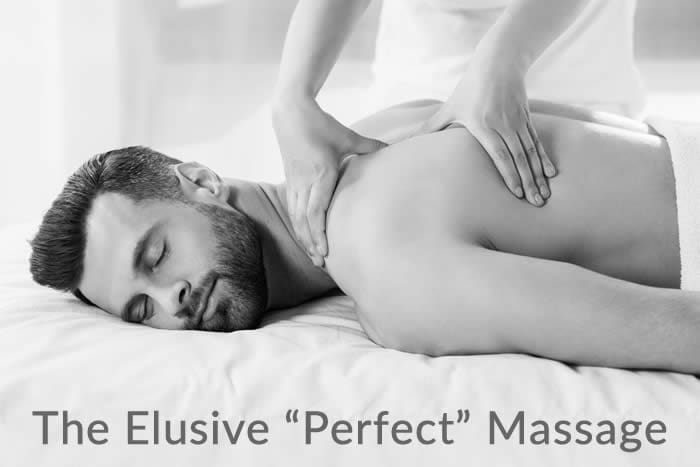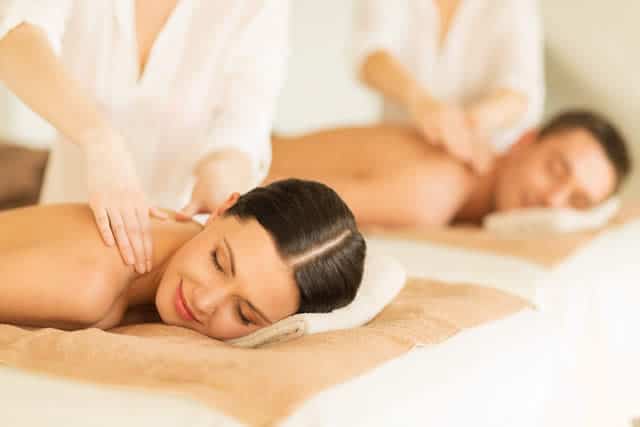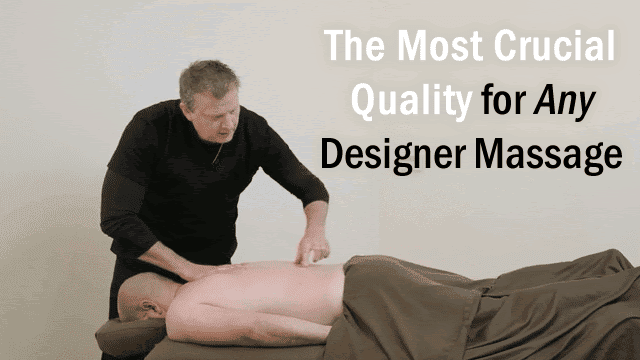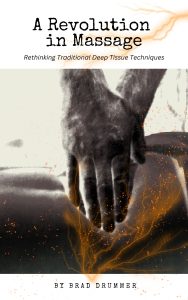

There are many designer massages and techniques in the world marketed as “the latest thing” and “the best massage you will ever have.” Every spa, cruise line or resort wishes to offer a signature experience that is unique to their company with the claim that it surpasses all other treatments, and is unlike any other massage in terms of healing and relaxation.
As someone who has been a resort spa therapist, a world class spa owner, and who is currently a consultant/instructor in massage for spas and resorts, I can say with some authority that it is nearly impossible to create a blueprint for a massage that guarantees results regardless of the type of client or therapist involved in the massage.
There are too many variables.
- What is the size, gender, age, medical restrictions, and pressure tolerance of the client?
- What are the physical capabilities of the therapist?
- What about the therapist’s talents not being utilized by the set routine of a directed massage?
Does this mean that spas should do away with signature treatments that the client can feel will be the same quality and content no matter who the therapist might be? No.
Good, Choreographed Massage Treatments
There are some good, choreographed massage treatments out there – and as a spa owner, I understand the desire to provide the client the comfort and assurance of knowing both what to expect when they enter the room and that what they will be experiencing will be a quality service with healing results – especially if there is more than one location of that spa brand.

And there are advantages for us as massage therapists in learning a designer massage with set sequences of strokes. This is especially true for the younger massage therapists fresh out of school trying to take all the styles and strokes learned at the massage institution and assemble them into a cohesive massage. A well put together pre-designed massage can help present a polished, professional, fully therapeutic, cutting-edge experience despite one’s lack of experience in the field.
Too Loose or Too Strict
But I must say that most of the designer massages that I have encountered in my travels focus heavily on rituals and gimmicks, and either give a very loose outline for the therapist to follow or are so rigid in how every stroke is to be applied that the therapist has no room to adapt to the needs of the client. In the case of the loose outline of how the strokes are to be applied it is the “props” that make the massage recognizable as they are the same every time, but the massage can vary greatly from therapist to therapist. And in the case of the strictly adhered to application of every stroke, there will be uniformity of experience no matter the therapist – but one is left with a complete disallowance for the client’s needs and a stifling of the therapist’s unique gifts.
I find these gimmicky massages are most often about selling a product – whether it is the candles, oils, bath salts, rollers, stones, teas, music, chimes, bowls, or even buffing gloves that were a part of the ritual. Some places I have visited offer a package of the items used in the treatment so that the client can experience it again in their homes – which shows you what kind of importance the massage played in the experience if it can be relived in a basket!
6 “Musts” for a Great Designer Massage Service
What I have learned is that there are a few “musts” that need to be a part of a choreographed designer massage or treatment for it to be a great service.
- Whatever the gimmick or the latest approach to massage therapy that sets the treatment apart it must make therapeutic sense that supports the session’s approach to the type of healing being rendered.
- Provides a warm-up/getting to know each other start to the session for both the client and the therapist to familiarize themselves with each other’s energy, tissue resistance/touch, fragrances, atmosphere, etc., while utilizing strokes that provide plenty of opportunities to palpate. This warm-up sequence/ritual also provides the chance to assure the client that whatever concerns that were raised have been noted, and to introduce in a gentle way the concepts of the approach to the session.
- Maximizes the potential of each stroke/moment while minimizing the use of throw away, filler, or transitional strokes.
- Permits the therapists to revisit an area of the client’s body several times throughout the session so the therapist will have multiple chances to “persuade” the troubled areas to release its tension/free its blockage.
- Is sequenced in a logical manner so that each subsequent stroke/ingredient in the session builds upon the previous moment until reaching the conclusion of the massage or the segment of the massage.
- Has ordered steps that do not rely on the quality of the therapist to make the treatment see results/be enjoyable. In other words – a great therapist will be able to enhance the experience, but a mediocre therapist will not be able to lessen the quality of the experience (short of negligence or being rude).
Most choreographed massage treatments manage to meet Steps 1&2 on my prerequisites list – but start falling short at Step 3 – and by the time we get to Step 6, very few remain.
The Most Crucial Quality for Any Designer Massage
And we still have not addressed what I feel is possibly the most important requirement for a preconstructed massage that will be effective and healing regardless of the talents and physical limitations of the therapist and/or the unique physique and needs of the client.
I speak of this crucial quality for any designer massage that wishes to be truly universal in my highly anticipated Interpretive Touch Massage course manual.
Excerpt From Upcoming Course: Interpretive Touch Massage
“… Sequencing is incredibly important to the success of a massage session. In theory, if we can arrange a sequence of strokes by which each stroke builds upon the effects of the preceding stroke while preparing the way and enhancing the stroke that follows, we will have created a seamless massage that makes every part of the client’s body feel intimately connected to every other part. And if the intent behind every stroke in the sequence is to make the client’s tissue feel amazing, then the massage becomes an hour-long series of blissful moments.
BUT – no matter how wonderful the choreography of sequenced strokes any massage might be – there must be room for the unique needs of each client AND the unique talents of each therapist in all set massage sessions. This is crucial. The perfect chocolate cake recipe is still unpalatable to someone who is allergic to chocolate. If the massage cannot adapt to the needs or contraindications of the client the whole recipe is useless.
First Encounter With A Marketed Massage
I believe that most massage therapists who have worked in the wellness industry have experienced having to learn a preset, directed massage session. My first encounter with a marketed massage with a definitive order to its strokes was shortly after graduating massage school. I had worked for a prestigious resort spa that brought someone in to train us in the latest European trend in massage. She arrived in six-inch heels with long, immaculately manicured nails wearing a dress more suited for an elegant cocktail gathering than teaching massage. We were told by the instructor that this European massage had been developed by a chemist as a vehicle for a very expensive massage oil line he created.
The massage went something like this:
‘Count five strokes with the left hand down the right side of the back. Do five strokes with your right hand down the left side of the back. Press with your right thumb down the left side of the spine 7 times. Do the same with your left thumb down the right side of the spine.’
And on and on it went, for every minute of the 60-minute session.
I was so traumatized by the un-therapeutic nature of what had been taught that I sat down with my manager and pleaded with him not to force me to do the massage. Besides the fact that this chemist had clearly invented the massage (that someone in a ballgown could perform) just to sell his perfumed oils rather than to therapeutically work muscle tissue, it left no room for what the client might actually need in the form of therapy, and left zero opportunity for me to apply my own experience and knowledge to the session.
Fortunately, I never had to perform this massage on a paying client because it was at this time that I was asked to teach my technique to other therapists.
Another Notable Experience
Another experience I had with a preset, directed massage session involved my own massage. One of the national spa companies that wanted to make my massage their signature massage asked me to devise a set massage based on one of my massage sessions, and then train their therapists how to perform the session. This is all well and good except this company wanted me to teach the therapists at all their locations across the country that they would be required to execute stroke for stroke that specific session with no deviations.
The spa owner said to me, ‘If you order a caramel frap from a Starbucks in LA it tastes exactly the same as one ordered in NYC.’ And that was what they wanted; a client who received my massage in Chicago would receive the exact same ‘tasting’ massage in Miami.
As a former spa owner, I can appreciate what they were hoping to accomplish in terms of brand recognition and quality control and assurance. It makes sure that as long as the therapist remembered and executed my strokes in my order to the depth I required, it did not matter so much whether the therapist was a gifted massage therapist. They were going to give a well put together massage full of effective strokes every time.
But this mindset can and will stunt the therapist’s creativity and limit their potential, while often ignoring the needs of the client that might not be addressed fully – or at all – within the exactly performed choreographed sequence of strokes. There is no perfect set of strokes that will suit every possible tissue need and therapist’s ability. It is just not possible.
Still – I understand the attractiveness and merit of having on a menu of services a massage that the client can feel confident in knowing they will be receiving a fantastic massage no matter who is the therapist.
So how does one resolve this dilemma?
As we spoke of earlier – if you just teach the strokes of a type of massage without requiring a set sequence of order in applying them, you run the risk of a completely unrecognizable massage that is actually therapeutically horrible. Like the cake recipe – exact same ingredients – one cake inedible and the other a culinary masterpiece.
You cannot really say ‘Here is an outline of a session – make of it what you want,’ or ‘Feel free to improvise as needed within the order of this massage,’ for the same reasons. An improvisation within a set of strokes designed to complement and enhance each other can ruin this outcome and be counterproductive to what the overall session is trying to accomplish. Coming back to the cake example, improvising with a recipe by deciding to use water instead of milk or stirring instead of whipping can ruin the cake even if every other step in the order is followed.
~ The Solution: Interpretive Spaces ~

The solution that I have come up with is to strategically place periods of time, called interpretive spaces, within the stroke sequences for the therapist to apply their talents, creativity, and interpretation of the client’s responses and needs, and to address the client’s specific issues unique to that person.
And by making these interpretive spaces a part of the order of sequence of strokes, you do not worry about improvisation to fit the client’s needs and wants negatively impacting the cumulative effects of a segment of sequenced strokes. This is why the interpretive spaces should always be placed after a segment of strokes that address a certain area of the body.
Interpretive spaces allow for the therapist to fill in the gaps of what might not have been addressed in terms of what the client needs before moving on to the next area of the body. It also allows for the therapist to bring their unique giftings to the massage and make the massage their own. Going back to the Starbuck’s example – the customer recognizes a Starbuck’s Frappuccino but now has the option of trying out a different therapist’s flavoring to perfectly match their specific tastes.
Leeway for Improvisation
It is my belief that ALL choreographed sessions should have the flexibility within the structured outline of strokes that gives leeway for improvisation within the outline to address all areas of the body without compromising the meaning behind the order of the strokes.
In short – all sessions would benefit from these interpretive spaces.”
In Conclusion
Interpretive spaces make it possible for that elusive perfect designer massage to exist.
Furthermore, as someone who wants to see the healing potentials of all massage to continue to evolve and grow in therapeutic value (which includes the massage techniques I have developed), by allowing in these interpretive spaces for the therapist to contribute their best strokes to the best sequence of strokes the creator of the designer massage has to offer, the sum result HAS to be greater than either alone.
Recommended Reading:














